Atlanta Chinese Dance Company
presented
In Search of the Imperial Palace
***click above for program synopsis***
on
May 25, 2003 at 7:30 PM
May 26, 2003 at 3:00 PM
at
Gwinnett Civic and Cultural Center
Duluth, Georgia
Staged and Directed by:
Hwee-Eng Y.
Lee
Guest Artist:
Tian Shuai, Atlanta Ballet
Main Characters:
Da
Lan Hua
Kerry Lee
Xiao Lan Hua
Catherine Chu, Kateri Goodwin, Allison Kwan,
Anna Meyer, Amy
Sanders, Christie Sui
LANTERN DANCE
 The
traditional Lantern Festival takes place on the fifteenth day of the eighth
month of the lunar calendar (and also on the fifteenth day on the first month).
On this day, the Chinese enjoy the full moon and the display of lanterns. The
full moon is celebrated in the Moon (or mid-Autumn) Festival by the reunion of
as many family members as possible. Moon cakes are a festival treat. In this
dance, the lanterns are used to create different patterns.
The
traditional Lantern Festival takes place on the fifteenth day of the eighth
month of the lunar calendar (and also on the fifteenth day on the first month).
On this day, the Chinese enjoy the full moon and the display of lanterns. The
full moon is celebrated in the Moon (or mid-Autumn) Festival by the reunion of
as many family members as possible. Moon cakes are a festival treat. In this
dance, the lanterns are used to create different patterns.
Choreography:
Hwee-Eng Y. Lee
[Top of page]
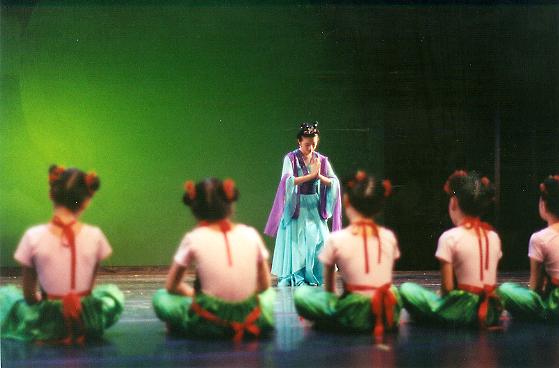 CHANG
E AND THE JADE RABBIT
CHANG
E AND THE JADE RABBIT
 According to a
Chinese fairy tale, a fairy named Chang E (pronounced “chang er”) floated to the
moon after drinking an elixir of immortality. Chang E’s pet, a jade rabbit,
drank the last drop of the elixir and floated to the moon as well. Many Chinese
children imagine that they can see a fairy and a rabbit in the moon. People
have historically paid their respects to Chang E and her rabbit during the Moon
Festival.
According to a
Chinese fairy tale, a fairy named Chang E (pronounced “chang er”) floated to the
moon after drinking an elixir of immortality. Chang E’s pet, a jade rabbit,
drank the last drop of the elixir and floated to the moon as well. Many Chinese
children imagine that they can see a fairy and a rabbit in the moon. People
have historically paid their respects to Chang E and her rabbit during the Moon
Festival.
Choreography: Hwee-Eng Y. Lee
[Top of page]
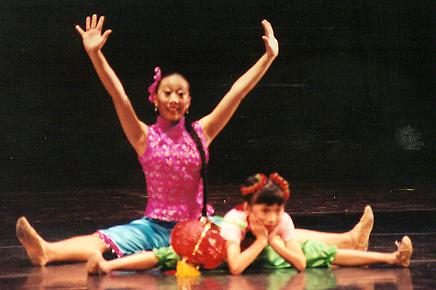 DA
LAN HUA AND XIAO LAN HUA
DA
LAN HUA AND XIAO LAN HUA
 After Xiao Lan Hua discovers that she is lost, Da
Lan Hua tries to cheer her up with a fan and scarf, two props commonly used in
Chinese dance. This dance incorporates techniques from various styles of fan
dance, including Anhui and Yunnan. In Anhui fan dance, the use of percussion
instruments is very important, as reflected by the “ting chang” sounds sang by
Xiao Lan Hua. Originally choreographed for a girl and her doll, this dance is a
Tao Li Cup award-winning piece.
After Xiao Lan Hua discovers that she is lost, Da
Lan Hua tries to cheer her up with a fan and scarf, two props commonly used in
Chinese dance. This dance incorporates techniques from various styles of fan
dance, including Anhui and Yunnan. In Anhui fan dance, the use of percussion
instruments is very important, as reflected by the “ting chang” sounds sang by
Xiao Lan Hua. Originally choreographed for a girl and her doll, this dance is a
Tao Li Cup award-winning piece.
Choreography: Beijing Dance Academy
[Top of page]
HARVEST
DANCE
 The
harvest
typically takes place in autumn. Children of the majority Han ethnic group
work happily
on the farm, harvesting their well-earned crops. In this dance, the
harvest is depicted through the dancers’ use of hats and scarves. The
scarves represent the crops, as well as the tool “biandan” used for carrying
crops. The hats also have a double meaning.
The
harvest
typically takes place in autumn. Children of the majority Han ethnic group
work happily
on the farm, harvesting their well-earned crops. In this dance, the
harvest is depicted through the dancers’ use of hats and scarves. The
scarves represent the crops, as well as the tool “biandan” used for carrying
crops. The hats also have a double meaning.
Choreography: Hwee-Eng Y. Lee
[Top of page]
 SPRING
IS EVERYWHERE
SPRING
IS EVERYWHERE
This contemporary Chinese dance was choreographed based on the Jiao Zhou
folk dance fan techniques of the Shandong province in northeast China. The
beauty of spring is symbolized through the grace of the young Chinese ladies and
the colorful fans that they carry.
Staged by: Hwee-Eng Y. Lee (after a Tao Li Cup
award-winning piece)
[Top of page]
 DAI
DANCE
DAI
DANCE
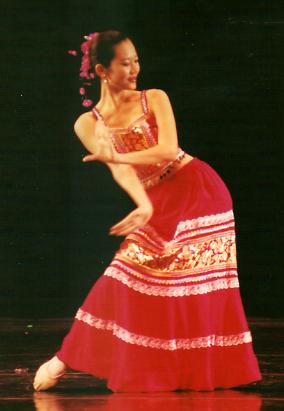 The
Dai minority ethnic group lives mostly in Yunnan province, located in southwest
China. Since the Dai live in close proximity to Myanmar (Burma), the style of
Dai dance is similar to the Burmese. Bouncy knees and angular arms and fingers
are characteristic of Dai dance. This dance, a contemporary interpretation, is
a Tao Li Cup award-winning piece.
The
Dai minority ethnic group lives mostly in Yunnan province, located in southwest
China. Since the Dai live in close proximity to Myanmar (Burma), the style of
Dai dance is similar to the Burmese. Bouncy knees and angular arms and fingers
are characteristic of Dai dance. This dance, a contemporary interpretation, is
a Tao Li Cup award-winning piece.
Choreography: Central Institute of Nationalities
[Top of page]
DUCK
DANCE

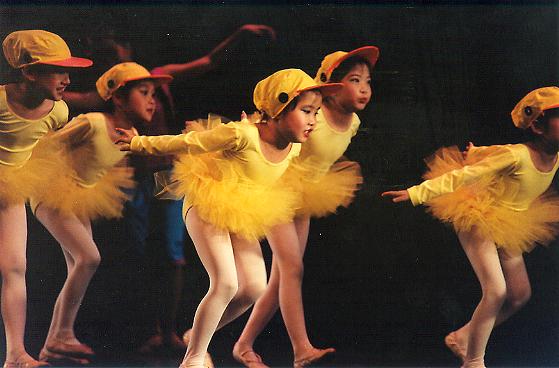 In this dance, a young Tibetan
girl chases a group of ducks. The ducks happily jump into the water
and eat the food given to them by the girl. At the end of the dance, the
girl leaves to go to school.
In this dance, a young Tibetan
girl chases a group of ducks. The ducks happily jump into the water
and eat the food given to them by the girl. At the end of the dance, the
girl leaves to go to school.
Choreography: Hwee-Eng Y. Lee
[Top of page]
 BOW
DANCE
BOW
DANCE
This
Han dance has its origins in the dance drama “Shanghai Dagger Society.” It
adopts techniques from Chinese opera and traditional wushu (martial arts) to
depict the Opium War (1839-42 and 1856-60) in China, which took place during the
period of Tai Ping Tian Guo (founded by rebel Hong Xiu Quan in the late Qing
dynasty to liberate Chinese people from imperial oppression.) In this dance, a
group of patriotic young women, determined to fight for their country, refine
their bow skills.
Choreography: Shanghai
Song and Dance Troupe (adapted by Hwee-Eng Y. Lee)
[Top of page]
 KITE
DANCE
KITE
DANCE
In
this piece, a young girl flies her kite in spring time. The dancers use two fans
to create the shape of the kite. At times, they represent the string of the
kite, and at other times, they depict the kite itself.
Choreography after Xu Chiu Ping by: Hwee-Eng Y. Lee
[Top of page]
 WOMEN
OF THE YELLOW RIVER BASIN
WOMEN
OF THE YELLOW RIVER BASIN
This Han dance incorporates “Yang Ge” techniques,
which originated with farmers in northeast China. In this piece, the married
women of the Yellow River Basin gossip happily while working hard at various
tasks, including washing clothes, sewing, farm labor, and carrying the “biandan.”
Choreography: Shanxi Province Song and Dance Troupe
[Top of page]
SHANXI
DRUM DANCE
Drums are a very popular prop in Chinese dance. In this piece, from the
Shou-La-Shou Arts Troupe,
the children of the Yellow River Basin hit two drums, one
on the chest, and the other
on top of their head, in intricate patterns.
Choreography: Huang Ying and Wang Rui Fen
[Top of page]
YELLOW
RIVER PIANO CONCERTO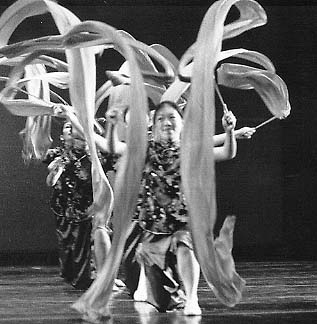
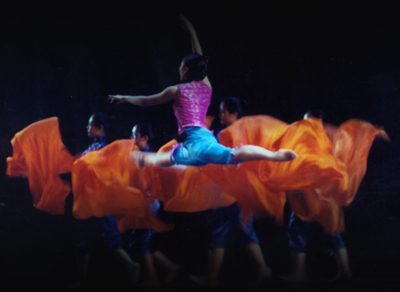
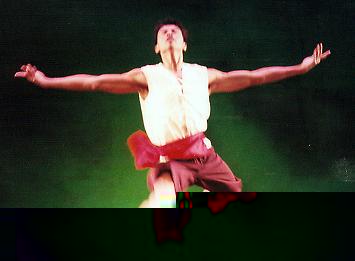 The Yellow River, or “Huang He” in Chinese, is named as after its murky color, which is caused by the
loess deposits in the river. The Yellow
River, sometimes called “China’s Sorrow,” is known for its rampant floods; the
people of the Yellow River Basin, represented by the male dancer, are often
forced combat the horrible flood-related conditions. Set to the well-known
Yellow River Piano Concerto, this work of modern Chinese dance was originally
choreographed for Beijing Dance Academy without the use of any props.
The Yellow River, or “Huang He” in Chinese, is named as after its murky color, which is caused by the
loess deposits in the river. The Yellow
River, sometimes called “China’s Sorrow,” is known for its rampant floods; the
people of the Yellow River Basin, represented by the male dancer, are often
forced combat the horrible flood-related conditions. Set to the well-known
Yellow River Piano Concerto, this work of modern Chinese dance was originally
choreographed for Beijing Dance Academy without the use of any props.
Choreography:
Zhang Yujun and Shen Peiyi (adapted by Hwee-Eng Y. Lee)
Guest Artist:
Tian Shuai, Atlanta Ballet (pictured above right)
[Top of page]
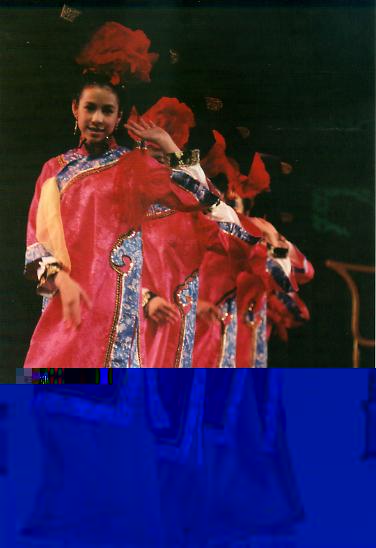 DANCE
OF THE MANCHURIAN CONCUBINES
DANCE
OF THE MANCHURIAN CONCUBINES
The Qing (or
Manchu) dynasty was the last dynasty of China’s dynastic cycle. The Manchu
people, who ruled the Qing dynasty, had very elegant costumes, which have had a
great influence on Chinese costume history. Their distinctive style includes of
headdresses and platform shoes.
Choreography: Yu Hong
[Top of page]
 SWORD DANCE
SWORD DANCE
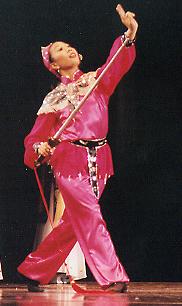
Sword
technique has gradually developed into a form of dance. Sword dance was already quite
advanced in the Tang dynasty, and has developed even further since. Movements
from the sword dance are forceful yet elegant. In this particular piece, from
the Dun Huang area, there is a long tassel attached to the sword, which
increases the difficulty of the technique as well as the beauty of the
movements.
Choreography: Shaanxi Province Classical Music and Dance
Troupe
[Top of page]
MONGOLIAN DANCE

Mongolians live on the vast prairie in the northern
part of China. Many of the people live as shepherds. Their traditional culture
has a close relationship with sheep, horses, and eagles. The dance uses cups, a
typical prop of traditional Mongolian dance. Although many Mongolian dances
evoke the image of life on the prairie, this classical dance is designed to be
performed in a palace.
Choreography: Inner Mongolia Song and Dance Troupe
[Top of page]
 TIBET DANCE
TIBET DANCE
Most Tibetans live
in the western part of China in the Tibet, Qinghai, Yunnan,
Gansu, and Sichuan provinces.
Typically, their clothing includes a multi-colored apron and long sleeves.
Sometimes, they only wear one sleeve, because the weather often changes rapidly
in a single day.
[Top of page]

 MOONLIGHT
OVER THE SPRING RIVER
MOONLIGHT
OVER THE SPRING RIVER
This
classical Chinese dance is choreographed to a famous tune. It depicts a group
of young ladies dancing under the moonlight with feather fans which are often
used to symbolize the moon.
Choreography: Margaret Yuen
[Top of page]
DUN
HUANG PIPA
DANCE

Dun
Huang music and dance developed during the Tang dynasty, one of the richest
periods in
Chinese art history. The classical Dun Huang dance style was influenced by
the Indians during the introduction of Buddhism into China. The images of the
dancers on ancient mural paintings in the past illustrated the unique Dun Huang
style in Chinese dance history. The pipa was a popular instrument during the
time period. In this dance, the style of “fantanpipa” (literally “playing the
pipa backwards”) is depicted throughout.
Choreography: Gansu Song and Dance
Troupe
[Top of page]
 XINJIANG
DANCE
XINJIANG
DANCE
Xinjiang,
located in the northwestern part of China, is the home of the Wei Wu Er ethnic
group, who love music and dance. The interesting neck and wrist movements are
the main characteristics of this style.
Choreography: Xinjiang Cultural Bureau
[Top of page]

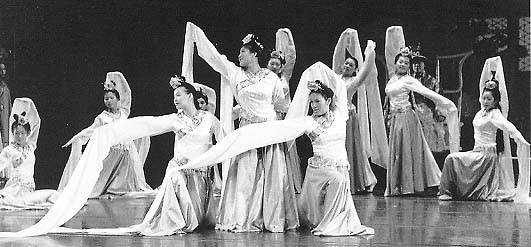 CHIME
OF THE BELLS
CHIME
OF THE BELLS
This dance was inspired by the archaeologists who discovered a tomb that
dates back to the Warring States period, some 2,400 years ago. The palace
banquet music is based on the folk melodies of Hubei. It shows the grand
entertainment in the palace with flowing, graceful long sleeves.
Choreography:
Hubei Province Song and Dance Troupe
[Top of page]
 CHINESE
CONTEMPORARY BALLET
CHINESE
CONTEMPORARY BALLET
Chinese contemporary ballet is a new style that has
developed in the past forty years. It incorporates classical ballet technique
into Chinese dance style. Examples of Chinese contemporary ballets in China
include the White-haired Girl, Red Detachment of Women, and Red Lanterns Hang
High. This piece, choreographed to music from Red Detachment of Women, uses
red embroidered balls. Traditionally, red is the symbol of happiness. Da Lan
Hua and Xiao Lan Hua’s gift for the emperor includes peach-shaped buns, a
customary birthday gift that symbolizes longevity.
Choreography: Hwee-Eng Y. Lee and Kerry Lee
[Top of page]
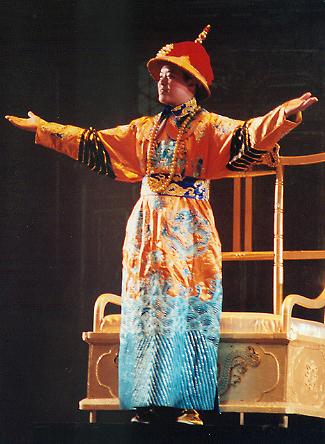 Finale
Finale
The emperor asks Da
Lan Hua and Xiao Lan Hua to stay, but they decide that "there's no place like
home.” All of the people of the Imperial Palace gather to say farewell to the
girls.
[Top of page]
 Xiao
Lan Hua's Return
Xiao
Lan Hua's Return
Da Lan Hua
takes Xiao Lan Hua back to her hometown, where Xiao Lan Hua’s friends are very
excited to see her. Xiao Lan Hua tells her friends about her adventures, but
they do not believe her.
[Top of
page]
Final
Bow
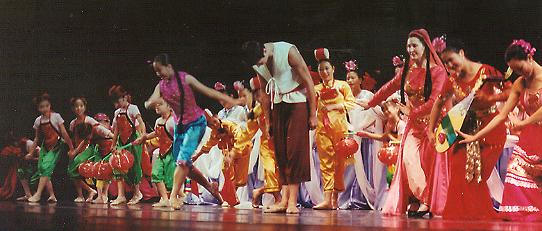
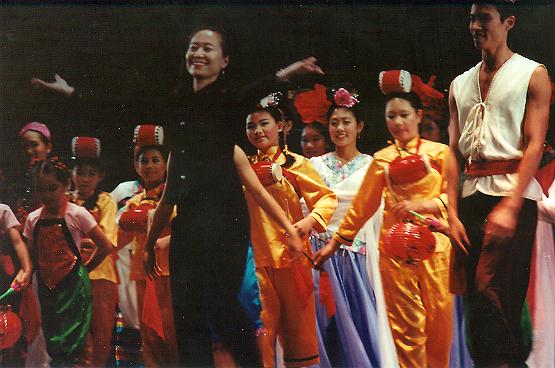
[Top of page]
Introduction
.|.
About
ACDC .|.
Past
Performances
Most
Recent Performance.|
.
Upcoming Performance
.
|.
Chinese
Dance History
Chinese
Dance Classes
Created by the Atlanta Chinese
Dance Company
Copyright reserved.
 The
traditional Lantern Festival takes place on the fifteenth day of the eighth
month of the lunar calendar (and also on the fifteenth day on the first month).
On this day, the Chinese enjoy the full moon and the display of lanterns. The
full moon is celebrated in the Moon (or mid-Autumn) Festival by the reunion of
as many family members as possible. Moon cakes are a festival treat. In this
dance, the lanterns are used to create different patterns.
The
traditional Lantern Festival takes place on the fifteenth day of the eighth
month of the lunar calendar (and also on the fifteenth day on the first month).
On this day, the Chinese enjoy the full moon and the display of lanterns. The
full moon is celebrated in the Moon (or mid-Autumn) Festival by the reunion of
as many family members as possible. Moon cakes are a festival treat. In this
dance, the lanterns are used to create different patterns. CHANG
E AND THE JADE RABBIT
CHANG
E AND THE JADE RABBIT According to a
Chinese fairy tale, a fairy named Chang E (pronounced “chang er”) floated to the
moon after drinking an elixir of immortality. Chang E’s pet, a jade rabbit,
drank the last drop of the elixir and floated to the moon as well. Many Chinese
children imagine that they can see a fairy and a rabbit in the moon. People
have historically paid their respects to Chang E and her rabbit during the Moon
Festival.
According to a
Chinese fairy tale, a fairy named Chang E (pronounced “chang er”) floated to the
moon after drinking an elixir of immortality. Chang E’s pet, a jade rabbit,
drank the last drop of the elixir and floated to the moon as well. Many Chinese
children imagine that they can see a fairy and a rabbit in the moon. People
have historically paid their respects to Chang E and her rabbit during the Moon
Festival.  DA
LAN HUA AND XIAO LAN HUA
DA
LAN HUA AND XIAO LAN HUA After Xiao Lan Hua discovers that she is lost, Da
Lan Hua tries to cheer her up with a fan and scarf, two props commonly used in
Chinese dance. This dance incorporates techniques from various styles of fan
dance, including Anhui and Yunnan. In Anhui fan dance, the use of percussion
instruments is very important, as reflected by the “ting chang” sounds sang by
Xiao Lan Hua. Originally choreographed for a girl and her doll, this dance is a
Tao Li Cup award-winning piece.
After Xiao Lan Hua discovers that she is lost, Da
Lan Hua tries to cheer her up with a fan and scarf, two props commonly used in
Chinese dance. This dance incorporates techniques from various styles of fan
dance, including Anhui and Yunnan. In Anhui fan dance, the use of percussion
instruments is very important, as reflected by the “ting chang” sounds sang by
Xiao Lan Hua. Originally choreographed for a girl and her doll, this dance is a
Tao Li Cup award-winning piece.
 SPRING
IS EVERYWHERE
SPRING
IS EVERYWHERE DAI
DANCE
DAI
DANCE The
Dai minority ethnic group lives mostly in Yunnan province, located in southwest
China. Since the Dai live in close proximity to Myanmar (Burma), the style of
Dai dance is similar to the Burmese. Bouncy knees and angular arms and fingers
are characteristic of Dai dance. This dance, a contemporary interpretation, is
a Tao Li Cup award-winning piece.
The
Dai minority ethnic group lives mostly in Yunnan province, located in southwest
China. Since the Dai live in close proximity to Myanmar (Burma), the style of
Dai dance is similar to the Burmese. Bouncy knees and angular arms and fingers
are characteristic of Dai dance. This dance, a contemporary interpretation, is
a Tao Li Cup award-winning piece.

 BOW
DANCE
BOW
DANCE KITE
DANCE
KITE
DANCE WOMEN
OF THE YELLOW RIVER BASIN
WOMEN
OF THE YELLOW RIVER BASIN


 The Yellow River, or “Huang He
The Yellow River, or “Huang He DANCE
OF THE MANCHURIAN CONCUBINES
DANCE
OF THE MANCHURIAN CONCUBINES  SWORD DANCE
SWORD DANCE 

 TIBET DANCE
TIBET DANCE
 MOONLIGHT
OVER THE SPRING RIVER
MOONLIGHT
OVER THE SPRING RIVER
 XINJIANG
DANCE
XINJIANG
DANCE
 CHIME
OF THE BELLS
CHIME
OF THE BELLS CHINESE
CONTEMPORARY BALLET
CHINESE
CONTEMPORARY BALLET Finale
Finale Xiao
Lan Hua's Return
Xiao
Lan Hua's Return

